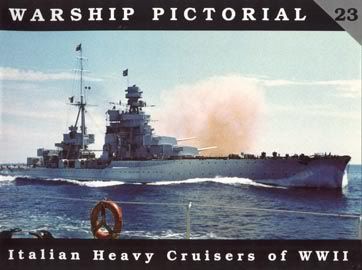I mainly just wanted to see what I needed to sacrifice in order to get good protection against 203mm weapons. Shes still vulnerable to torpedoes, I needed to increase the size quite a bit to take that into account. The armour isn't really a waste, she can wipe the floor with 152mm gunned opponents.
I might add a very short foremast like with historical Zara and Bolzano. The forward tower is a bit lower than it should be. I'll fix it.
Below is the version with even more armour and protection against torpedoes. Too big and too little firepower for me I think though. She does look good though.

Enter ship name, Enter country Enter ship type laid down 1932
Displacement:
12,886 t light; 13,476 t standard; 15,238 t normal; 16,649 t full load
Dimensions: Length overall / water x beam x draught
650.31 ft / 629.92 ft x 70.01 ft x 24.93 ft (normal load)
198.21 m / 192.00 m x 21.34 m x 7.60 m
Armament:
9 - 7.99" / 203 mm guns (3x3 guns), 276.24lbs / 125.30kg shells, 1932 Model
Breech loading guns in turrets (on barbettes)
on centreline ends, majority forward, 1 raised mount - superfiring
20 - 3.94" / 100 mm guns (10x2 guns), 33.07lbs / 15.00kg shells, 1932 Model
Dual purpose guns in deck mounts with hoists
on side, all amidships
18 - 1.85" / 47.0 mm guns (6x3 guns), 3.86lbs / 1.75kg shells, 1932 Model
Anti-aircraft guns in deck mounts
on side, all amidships, all raised mounts - superfiring
Weight of broadside 3,217 lbs / 1,459 kg
Shells per gun, main battery: 150
12 - 23.6" / 600 mm above water torpedoes
Armour:
- Belts: Width (max) Length (avg) Height (avg)
Main: 2.95" / 75 mm 423.23 ft / 129.00 m 9.19 ft / 2.80 m
Ends: Unarmoured
Upper: 6.44" / 164 mm 423.23 ft / 129.00 m 9.84 ft / 3.00 m
Main Belt covers 103 % of normal length
- Torpedo Bulkhead:
1.57" / 40 mm 423.23 ft / 129.00 m 24.61 ft / 7.50 m
- Gun armour: Face (max) Other gunhouse (avg) Barbette/hoist (max)
Main: 7.48" / 190 mm 4.92" / 125 mm 5.91" / 150 mm
2nd: 1.18" / 30 mm 1.18" / 30 mm -
3rd: 0.79" / 20 mm - -
- Armour deck: 2.72" / 69 mm, Conning tower: 5.91" / 150 mm
Machinery:
Oil fired boilers, steam turbines,
Geared drive, 2 shafts, 84,000 shp / 62,664 Kw = 31.20 kts
Range 6,000nm at 20.00 kts
Bunker at max displacement = 3,173 tons
Complement:
685 - 891
Cost:
£5.043 million / $20.170 million
Distribution of weights at normal displacement:
Armament: 371 tons, 2.4 %
Armour: 4,459 tons, 29.3 %
- Belts: 1,599 tons, 10.5 %
- Torpedo bulkhead: 607 tons, 4.0 %
- Armament: 659 tons, 4.3 %
- Armour Deck: 1,517 tons, 10.0 %
- Conning Tower: 78 tons, 0.5 %
Machinery: 2,479 tons, 16.3 %
Hull, fittings & equipment: 5,476 tons, 35.9 %
Fuel, ammunition & stores: 2,353 tons, 15.4 %
Miscellaneous weights: 100 tons, 0.7 %
Overall survivability and seakeeping ability:
Survivability (Non-critical penetrating hits needed to sink ship):
22,364 lbs / 10,144 Kg = 87.6 x 8.0 " / 203 mm shells or 3.7 torpedoes
Stability (Unstable if below 1.00): 1.16
Metacentric height 3.9 ft / 1.2 m
Roll period: 14.9 seconds
Steadiness - As gun platform (Average = 50 %): 51 %
- Recoil effect (Restricted arc if above 1.00): 0.40
Seaboat quality (Average = 1.00): 1.03
Hull form characteristics:
Hull has a flush deck
and transom stern
Block coefficient: 0.485
Length to Beam Ratio: 9.00 : 1
'Natural speed' for length: 28.94 kts
Power going to wave formation at top speed: 54 %
Trim (Max stability = 0, Max steadiness = 100): 50
Bow angle (Positive = bow angles forward): 30.00 degrees
Stern overhang: 6.56 ft / 2.00 m
Freeboard (% = measuring location as a percentage of overall length):
- Stem: 23.95 ft / 7.30 m
- Forecastle (20 %): 19.03 ft / 5.80 m
- Mid (50 %): 17.39 ft / 5.30 m
- Quarterdeck (15 %): 17.39 ft / 5.30 m
- Stern: 19.03 ft / 5.80 m
- Average freeboard: 18.48 ft / 5.63 m
Ship tends to be wet forward
Ship space, strength and comments:
Space - Hull below water (magazines/engines, low = better): 102.6 %
- Above water (accommodation/working, high = better): 113.6 %
Waterplane Area: 30,137 Square feet or 2,800 Square metres
Displacement factor (Displacement / loading): 122 %
Structure weight / hull surface area: 121 lbs/sq ft or 590 Kg/sq metre
Hull strength (Relative):
- Cross-sectional: 0.97
- Longitudinal: 1.25
- Overall: 1.00
Hull space for machinery, storage, compartmentation is adequate
Room for accommodation and workspaces is adequate
150mm Machinery 190mm Magazines=165.21 average
25mm forward
70mm Machinery 90mm Magazines
70mm stearing gear
=68.51average


Quoted
Can you see a foremast here?
